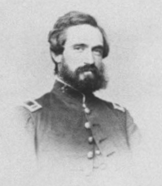William Greene Turner facts for kids
Quick facts for kids
William Greene Turner
|
|
|---|---|
 |
|
| Born | October 21, 1833 Newport, Rhode Island
|
| Died | 1917 Newport, Rhode Island
|
| Nationality | American |
| Known for | sculpture |
William Greene Turner (born October 21, 1833 – died 1917) was a talented American sculptor. He created many beautiful statues and artworks, some of which you can still see today!
Early Life
William Greene Turner was born in Newport, Rhode Island. His parents were James Varnum Turner and Catherine (Greene) Turner.
A Soldier in the Civil War
Before he became a sculptor, William Greene Turner was a dentist. When the American Civil War began, he joined the army. On June 5, 1861, he became a sergeant in Company K of the 2nd Rhode Island Infantry. Interestingly, his brother, Captain Charles W. Turner, was in charge of the same company!
Soon after, William was promoted to a second lieutenant. This happened because someone was injured during the First Battle of Bull Run, a big battle fought just the day before. He was promoted again to first lieutenant in November 1861.
In April 1863, Turner became a captain and led Company G of the 2nd Rhode Island. Not long after, he was injured in battle on May 3 at the Battle of Salem Church in Virginia. This battle was part of the larger Battle of Chancellorsville campaign. He sent a short message to his brother, Dr. Henry E. Turner, saying he was wounded but that his pocket book had helped save his life, so it wasn't too serious.
Because of his injuries, Captain Turner left the army on July 21, 1863. His family then sent him to Italy, hoping the warmer climate would help him recover.
Becoming an Artist
While in Italy, William Greene Turner quickly fell in love with the amazing sculptures made by artists during the Italian Renaissance. He was especially inspired by the art in Florence, where he was staying.
With help from his uncle, William Greene decided to stay in Florence for the next thirty years! He opened a studio there and received many requests for his art from private collectors and even the new Italian government. You can find examples of his marble and alabaster sculptures at the Redwood Library and Athenaeum and the Newport Historical Society in Rhode Island.
Like many artists of his time, he became an American living abroad to study and perfect his art. His sculptures were shown in famous art shows in Rome and Paris during the 1870s and 1880s.
One of Turner's most famous works in America is his bronze statue of Oliver Perry Monument. This statue was revealed on September 10, 1885, in Newport, Rhode Island. It stands in a park now called Eisenhower Park.
In 1890, Turner was made an honorary member of the Rhode Island Society of the Cincinnati.
Later in his life, William Greene Turner moved back home to Newport from Italy. He spent his final years creating more sculptures in the United States. A sculpture he made of his brother, Dr. Henry E. Turner, who was a famous gardener in Newport, is now owned by the Newport Historical Society.
Personal Life
William Greene Turner never married. He passed away in 1917 and is buried in the Common Burying Ground and Island Cemetery in Newport.

